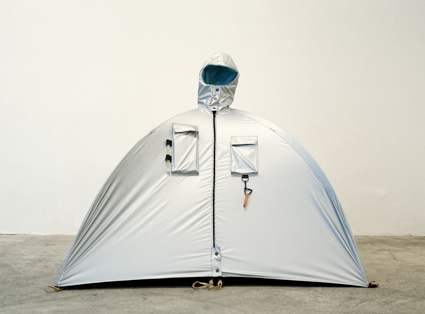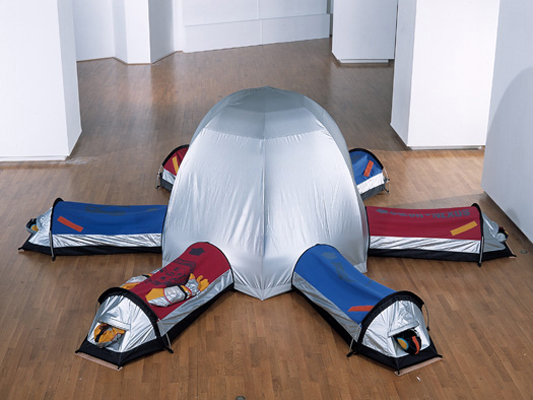|
|
| home | features | exhibitions | interviews | profiles | webprojects | gazetteer | links | archive | forum |
|
Lucy Orta Plymouth Arts Centre and Plymouth College of Art 16/9/09-18/11/09 16 September – 8 November 2009 OK. I’ll admit it. When I first entered the Viewpoint Gallery at Plymouth College of Art on Tuesday, September 29, I laughed. A silver dome-tent sprouting six multicoloured sleeping bags was positioned in the middle of the floor. A series of interconnected jackets and sleeping bags sporting dangling, tentacle-like orange gauntlets was hanging from the ceiling. The exhibits looked as though they belonged on a space station. I was intrigued.
Orta is an artist who uses her studio work together with performances, public interventions and workshops to challenge society and stimulate debate on a wide range of issues, including identity, community, homelessness and the environment. Her ‘wearable architecture’ including the circular tent ‘organism’ Body Architecture – Foyer D and the hanging Connector Mobile Village IX present radical new ways of living and establishing identities in our constantly-changing environment. Each part of these structures have the ability to be independent yet still rely on the whole for survival. Orta also works with those on the edges of society. Refuge Wear City Interventions 1993-1996, features clothing designed in collaboration with the homeless and misplaced. This work seeks not only to provoke discussion about the rights of all citizens to participate in society, but also how identity is formed through what we wear. The capacity of clothing to both create communities and isolate individuals is a theme continued in Orta’s Nexus Architecture, featuring clothes with detachable material ‘umbilical cords’. It’s a diverse exhibition. At Plymouth Arts Centre, displays feature garments made with residents of a Parisian refuge and a South African shelter, a collection of decorated plates from a series of community meals and pots of jam and syrup made from food salvaged from a French marketplace.
The Transition Movement, with its emphasis on sustainability, the numbers of people tending allotments, and the popularity of Farmers’ Markets and Eat Local initiatives all echo Orta’s Hortirecycling project with its aim of transferring power from mass agriculture back to people. The spirit of Orta’s deconstruction and recombination of old, second-hand clothing into new items in the Identity+Refuge exhibit is also evident in the renaissance of charity shops, popularity of Stitch and Bitch groups and the rise in sales of sewing machines. And the ability of food to bring together communities, as Orta did in her 70 x 7 The Meal project, was exploited by The Big Lunch initiative earlier this year – promoted as ‘a day to break bread with our neighbours, to put a smile on Britain’s face’. It would appear from that list that much has been achieved through people like Orta. Unfortunately, as I passed the largely ignored Big Issue seller outside Drake Circus and fought my way through Primark and the racks of cheap, easily-disposable, mass-produced clothing to catch the bus home, it seems that we still have a way to go… Heather Smith 2/10/09 article first appeared on 'The Peoples Republic of South Devon' |
|
|

 Lucy
Orta is the subject of an exhibition jointly staged by Plymouth College
of Art and Plymouth Arts Centre. The show features over 10 years of her
internationally exhibited work and was recently included on the
Guardian’s list of best art shows. And with that CV, I don’t think Ms
Orta will be too worried about my initial reaction to the exhibition.
Lucy
Orta is the subject of an exhibition jointly staged by Plymouth College
of Art and Plymouth Arts Centre. The show features over 10 years of her
internationally exhibited work and was recently included on the
Guardian’s list of best art shows. And with that CV, I don’t think Ms
Orta will be too worried about my initial reaction to the exhibition. Although
most of the work on show is from the early 1990s, Orta’s exhibition
feels very fresh. Perhaps it is because they were produced, as the
accompanying notes state ‘against a backdrop of struggling economic
recession and high unemployment’ that they resonate so acutely now.
Although
most of the work on show is from the early 1990s, Orta’s exhibition
feels very fresh. Perhaps it is because they were produced, as the
accompanying notes state ‘against a backdrop of struggling economic
recession and high unemployment’ that they resonate so acutely now.